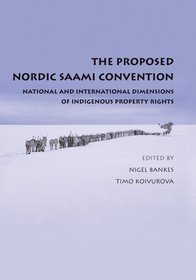Search -
The Proposed Nordic Saami Convention
The Proposed Nordic Saami Convention
In 2005, an expert group representing the governments of Norway, Sweden, and Finland, as well as the Saami parliaments of these countries (Saami are the Nordic indigenous people), agreed upon a draft text of a Nordic Saami Convention. Key parts of the text deal with the recognition of Saami land and resource rights. More recently, the three gove... more »
In 2005, an expert group representing the governments of Norway, Sweden, and Finland, as well as the Saami parliaments of these countries (Saami are the Nordic indigenous people), agreed upon a draft text of a Nordic Saami Convention. Key parts of the text deal with the recognition of Saami land and resource rights. More recently, the three gove... more »
ISBN-13: 9781849462723
ISBN-10: 1849462720
Publication Date: 1/31/2013
Pages: 336
Rating: ?
ISBN-10: 1849462720
Publication Date: 1/31/2013
Pages: 336
Rating: ?
0 stars, based on 0 rating
Genres:




